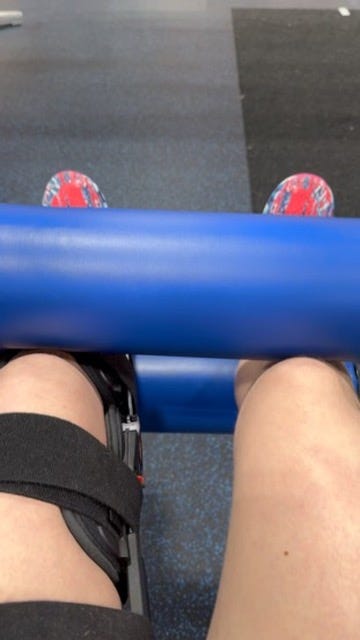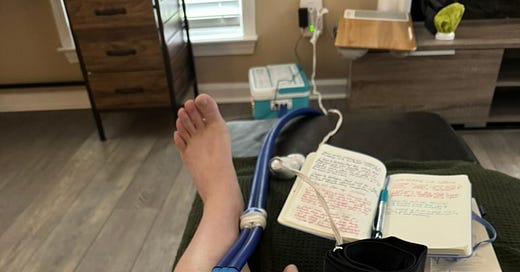The Duality of Comfort
Reflections on my former ability to be "comfortable in the uncomfortable," the limits of discomfort as a means of growth, and scoping "constructive discomfort" on the road to recovery
Hi there and happy Sunday. I’m forty-four days out from surgery and have been thinking a lot about the theme of comfort as it applies to the process of recovery.
It’s a hard balance to strike: staying comfortable enough to support your healing but making yourself uncomfortable enough—in controlled ways—so you can regain the pieces of functionality, movement, and confidence that will allow you to live your life normally again.
This rambles a bit, but if you’re reading, if nothing else, I hope you leave with a greater, more visceral sense of what comfort and discomfort have looked like in my life over the last few weeks and how that’s a sea change from how they used to look before the surgery and the injury.
My Pre-Op Relationship with Comfort
There’s this one jiu-jitsu apparel company that frequently shows up in my Instagram feed and tries to sell me products that tout the mantra, “Comfort is a slow death. Prefer pain.”
While I’ve never succumbed to the algorithm and bought any of their merchandise, the mentality of pushing yourself in order to improve yourself is one that usually resonates with me, especially on the mat.
I liked to think that after seven years of jiu-jitsu, I was “comfortable with being uncomfortable.” In many ways, this was true. I could stay calm when someone my size was glued to my back, trying to choke me. I remained fearless—at least in the training room—when a man twice my size mounted on top of me and tried to smother me. With steady breathing and clear thinking, I could endure the pressure of someone putting their body weight into my jaw or joints. At best, I endured long enough to escape danger. At worst, I tapped out and lived to fight another round.
Jiu-jitsu, for me, was a daily practice of never being too comfortable. There was always a way to go into “deeper water” to grow, whether it was through learning new techniques, sparring from specific situations, or simply trying to survive against younger, more athletically gifted competitors—most notably, the teenage wunderkinds who had essentially begun their training moments after leaving the womb.
The more proficient you become at jiu-jitsu, the more your growth depends on intentional discomfort, both physically and mentally. Physically, intentional discomfort might mean forcing yourself to play on your non-dominant side or deliberately practicing a different style. Mentally, it often means putting yourself in bad positions and trying to escape or being willing to lose the round—if not many rounds—while trying to master something new.
What I loved most about jiu-jitsu was the appealing endlessness of the journey: as long as I was willing to put myself in uncomfortable positions and remained of sound enough mind and body, I could always grow in the practice.
Then the injury happened. Then the surgery happened. Then any previous conception of what discomfort I could tolerate completely changed.

Rethinking Comfort Post-Surgery
During surgery and the early post-op process, the goal is to “keep you comfortable.” Before anesthesia, doctors offer you a nerve block lasting up to 48 hours. After surgery, they prescribe heavy painkillers for when the nerve block wears off. You are bruised, swollen, and a little bloody under the hospital dressing, but for the most part, the trauma is controlled and comfortably numbed by science.
At home, you try to stay comfortable. You ice and elevate to reduce swelling. You read, watch Netflix, or play video games to distract yourself from the discomfort of everyday movements—putting on shoes, going to the bathroom, getting a glass of water—which are laborious and inherently uncomfortable. The layers of gauze and ACE bandages that cover and compress the wounds allow you to briefly forget that you have been sliced, screwed, stitched, and sealed back together from the inside out.
In the earliest days, the tactics, therapies, and medicines to induce or support comfort are crucial. Without them, you don’t sleep well. You become irritable with the people caring for you. Stress does not help your recovery in the early days. You must prioritize comfort to begin healing. Rest is the priority. The more rest, the better.
But physically, at a certain point, you don’t want to be too comfortable—and they don’t let you. They put you in physical therapy as quickly as possible. They make you put as much weight as you can tolerate on your operative leg. They make you move in controlled circumstances—at home or the PT facility—and with specific constraints—wearing an immobilizing brace locked to specific increments of flexion that you “earn” every two weeks in doses of thirty degrees: 30, then 60, then 90 degrees.
Aside from exercises recommended by your physical therapist, major activity is discouraged. Rest is still a priority, and movement is curtailed. Pain is not okay, but some discomfort is—and it’s expected.
When they take the stitches out at two weeks and unlock you to thirty degrees of movement, things feel a little more comfortable. You trust that your body can hold itself together, no longer needing synthetic threads to keep the surgically split skin closed. Your open wounds are closing. You can shower without waterproof bandages and, once the Steri-strips fall off, start slathering cocoa butter on the scars. Your body can hold itself together on the surface, even as things continue to gel, mold, and swell beneath.
The tiny spark-shaped wounds where the stitches were are like little fireworks, marking where the instruments needed to heal you were scoping, probing, and anchoring inside. The scars from them are little stars in a constellation you gaze at daily, hoping a cosmic force is guiding your recovery. These constellations sit atop an angry globe of blood, inflammation, and synovial fluid where a defined kneecap used to be.
You grind through PT exercises. As you tense your quad, you envision shape beneath the round, gushy dome. You press the back of your knee into a towel, trying to crush it with all the diminished force you can muster. You do calf raises, clamshells, and weight shifts from side to side. TENS units and Therabands help activate or compensate for muscles and movements still out of reach. Everything is a progression intended to help you straighten or bend your leg a little more each time.
On the street, toddlers jet past you on the sidewalk, moving three times as fast as your best limping pace.
At the supermarket, couples twice your age breeze past you—first in the parking lot, then in the freezer aisle, where they’re buying ice cream and you’re buying bags of ice for the machine that pumps freezing water around your knee.
It’s excruciating to exist in a black hole, a “square one” step down from your previous physical capability. It’s humiliating to feel childish compared to children and old compared to the elderly.
Infirmity is a mindfuck, but the worst mindfuck is uncertainty. You wake up in your weakened body day after day, searching for the one thing about you that is 1% better. You seek insights in threads and posts about others’ experiences to find hope or confidence in your recovery timeline. But in the end, you cannot truly predict when you, in your specific uniqueness, will be “back to normal.”

Redefining the “Safe” Scope of Discomfort
Before the surgery, I was the kind of person who just pushed through, considering myself mentally strong enough to handle fatigue, frustration, and pain.
Right now, I can’t be that person. Surgery and recovery have forcibly readjusted my baseline definitions of comfort. The truth is, while I can tolerate discomfort, I can only tolerate so much, and I am really, really afraid of pain.
My physical therapist talks about pain as the difference between “safe” and “unsafe” pain. “Safe pain” is when you’re pushing through ranges of motion at the appropriate timeline to regain stability, mobility, or function. “Unsafe pain” is when you’re doing things that risk the integrity of the operation.
Recovery is a difficult game of “finding the line” between safe and unsafe pain, beneficial comfort and complacency, beneficial discomfort and undermining your recovery.
I look forward to the day I can be back on the mat, exploring the constraints of my own deliberate discomfort in a training session. I am a long way from that. My life still depends on consistently executing fundamental movements, some of which I can or cannot do depending on the day. Some days, I can sit on the bike and pedal through a full range of motion for forty-five minutes. Other days, I cannot move through a single repetition, my attempts at pedaling as fruitless as trying to grease an angry, sticky hinge on an ancient door.
For now, when people ask me what it is like, how things are going, and when I’ll be “back,” the best way I can answer is by explaining what is or isn’t comfortable at a given moment.
I hope that in a few weeks, more things will lie in my realm of comfort. I look forward to confidently stepping over a small hurdle or stepping up with my surgical leg on a single stair. The day can’t come soon enough when I might be able to walk without a limp and without looking down at my feet to ensure every step is safe.

Closing out
If you’ve made it this far, thanks for reading.
If you know someone who can benefit from reading this, consider sharing using the button below:
If you want to make this reading relationship with my recovery journey a little more official, consider subscribing (and if you’re subscribed already—thank you so much):
Until next week, be well,
EZ



